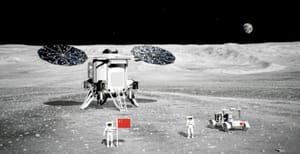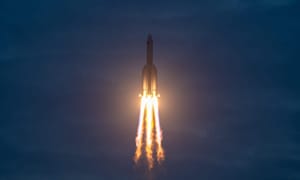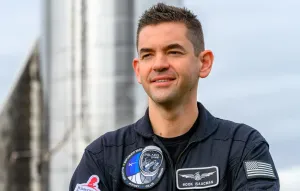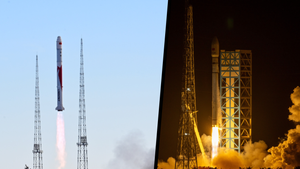
Oct 15, 2024
China shares space science goals for 2050
On October 15th, the China National Space Administration, the Chinese Academy of Sciences, and the China Manned Space Agency announced a plan for the next twenty-five years of space exploration. These three agencies released a document, titled National Space Science Medium-and Long-Term Development Plan (2024-2050), which outlines general objectives for China to work towards.
The full translated text from the three agencies is as follows:
To implement the guidelines of the 20th National Congress of the Communist Party of China and the decisions of the Second and Third Plenary Sessions of the 20th Central Committee, and to promote comprehensive development in space science, space technology, and space applications, this plan has been formulated to guide the deployment of space science missions and research in the current and future periods.
I. Development Goals
(1) Overall Goal
Gradually plan and implement national space science missions, integrate and strengthen mission-driven basic research, build a high-level talent team in space science, continuously achieve significant original results with major international impact, and realize high-quality development in space science. This will drive innovations in space technology, promote upgrades in space applications, and position China at the forefront internationally, becoming a leading power in space science.
(2) Phased Goals
By 2027
- Achieve a substantial improvement in scientific research levels, continuously obtaining world-class results in disciplines where there is a foundation and advantage, such as high-energy time-domain astronomy, Sun-Earth connection, the formation and evolution of the Moon and Mars, microgravity physics, and space life sciences.
- Implement a series of space science missions, establishing 5 to 8 space science tasks in scientific frontiers like dark matter, extreme universe, gravitational waves, protostellar clouds, exoplanets, solar activity, and solar system and Earth system exploration. This includes 2 to 3 major missions expected to produce significant landmark results.
- Make significant progress in creating a new space development landscape, cultivate leading figures and pioneers in the field of space science, enhance the talent team, and strengthen international status and influence.
2028–2035
- Lead in key areas internationally, with significant clusters of original achievements emerging in fields like mid- and low-frequency gravitational waves, the dark ages of the universe, discovery of habitable Earth-like planets, solar activity, Earth system response, lunar in-situ resource utilization, signs of life on Mars, black holes and neutron stars, and dark matter and dark energy.
- Implement a series of space science missions, establishing about 15 space science tasks in frontier areas such as the early universe, new physics in extreme celestial bodies, nearby habitable exoplanets, solar system early archaeology, extraterrestrial life exploration, solar flares, coronal heating mechanisms, and solar system boundary detection, including 4 to 5 large missions.
- Achieve comprehensive development in space science, space technology, and space applications, establishing a competitive advantage in talent, with China’s strategic talent pool and leading experts ranking among the top in the world.
2036–2050
- Achieve global leadership in key areas, becoming a world power in space science. Attain revolutionary breakthroughs in basic research on the origins and evolution of the universe, the nature of space-time, the solar system, and the origins of life, expanding the boundaries of human knowledge and advancing human civilization.
- Lead global space science development, carrying out more than 30 space science missions, possessing core competitiveness and strong leadership in the new round of scientific and technological revolution.
- Gather world-leading scientific teams and establish China as a major global center for space science and innovation, marking an important milestone in becoming a modern socialist power.
II. Priority Development Areas
Focusing on the frontiers of global space science and China’s major strategic needs, and building on China’s existing advantages in disciplines, talent, and engineering, five major scientific themes and their priority directions are identified for breakthrough opportunities.
- Extreme Universe Theme: Explore the origin and evolution of the universe and reveal the physical laws under extreme conditions. Priority directions include dark matter and the extreme universe, the origin and evolution of the universe, and baryonic matter detection. Major scientific problems to be solved include the nature of dark matter particles, sources of high-energy cosmic radiation, the nature of dark energy, dynamic universe detection and transient source mechanisms, the dark ages and reionization history, and the origin and evolution of stellar and planetary systems.
- Ripples in Space-Time Theme: Detect mid- and low-frequency gravitational waves and primordial gravitational waves, revealing the nature of gravity and space-time. Priority direction is space-based gravitational wave detection. Major scientific problems include the formation of supermassive and seed black holes, their co-evolution with host galaxies, detailed structures of strong gravitational fields near black holes, and the distribution and physical properties of compact celestial bodies, as well as testing early cosmological models.
- Sun-Earth Panorama Theme: Explore the Earth, Sun, and heliosphere to reveal the physical processes and laws governing the complex Sun-Earth system and the overall solar system connection. Priority directions include Earth’s circulation system, integrated Earth-Moon observation, space weather detection, solar stereoscopic detection, and outer heliosphere exploration. Major problems to solve include solar magnetic activity characteristics and origins, the three-dimensional propagation and evolution of solar wind disturbances, mechanisms of energy transfer and dissipation across scales from solar wind to the magnetosphere, magnetosphere-ionosphere-thermosphere coupling, multi-scale interactions in Earth’s system layers, and solar wind–interstellar medium interactions.
- Habitable Planet Theme: Explore the habitability of celestial bodies within the solar system and exoplanets, and search for extraterrestrial life. Priority directions include sustainable development, solar system archaeology, planetary layer characterization, extraterrestrial life exploration, and exoplanet detection. Major scientific issues to address include the Moon’s deep material, structural layers, and early impact history, the origin and evolution of asteroids/comets, the evolution of Mars' habitable environment and signs of life, interactions between solar wind and Jupiter’s magnetosphere, detection of habitability and life signals on icy moons and ice giants, and the habitability and biosignatures of exoplanets.
- Material and Life in Space Theme: Uncover the principles of matter and life under space conditions, deepening the understanding of fundamental physics such as quantum mechanics and general relativity. Priority directions include microgravity science, quantum mechanics and general relativity, and space life science. Major scientific problems involve complex fluid physics under new microgravity systems, quantum effects in gravitational fields, high-precision testing of general relativity, new physics explorations, and the adaptability and survival strategies of Earth life in space.
III. Development Roadmap
Focusing on the five major scientific themes and priority directions, the plan proposes a three-phase roadmap for scientific mission implementation up to 2050.
- First Phase, by 2027: Operate China’s space station, carry out manned lunar exploration, the fourth phase of the lunar exploration program, and planetary exploration projects, achieving internationally influential original results. Select 2–3 large missions from areas such as multi-band space-based X-ray observation, space X-ray baryon detection, space-based gravitational wave detection pathfinders, and solar polar exploration. Also, select 3–5 medium and small or opportunity-based missions from areas like dark matter detection, space-based terahertz imaging, long-wavelength space observation, and exoplanet exploration.
- Second Phase, 2028–2035: Achieve original results at the forefront of global space science through first-phase missions. Operate China’s space station and implement lunar exploration, lunar research station, solar system boundary exploration, giant planet system exploration, and Venus atmosphere sampling return missions. Select 4–5 large missions from areas like high-precision space-based infrared observation, space high-energy X-ray detection, and ring-Sun exploration, along with 10–11 medium, small, or opportunity-based missions.
- Third Phase, 2036–2050: Achieve global leadership in key space science fields, implementing 5–6 large missions and around 25 medium, small, and opportunity-based missions.
To achieve these goals, China will strengthen organizational efforts, ensure financial investment, solidify foundational capabilities, deepen international cooperation, and promote public science education to achieve major original and leading scientific breakthroughs, supporting the development of China as a space power and technological power.
(If there are any problems with this translation please reach out and correct me.)
Following the release of this document, China's State Council Information Office held a press conference to answer questions from the media. Some of the questions and answers from the conference are summarized below.
Regarding China's science satellites, what achievements have been made? Last decade China launched several science satellites but operates fewer than other space powers. By 2050 China is seeking to catch up in this area and become a leading space power.
For deep space exploration, what progress is being made? Chang'e 7 and Chang'e 8 are undergoing work for launch in 2026 and 2028 respectively, also for lunar exploration the International Lunar Research Station is currently undergoing research and development as well as planning with partner organizations and countries. Tianwen-2, Tianwen-3, and Tianwen-4 are also actively being worked towards, with Tianwen-2 set to launch in 2025 to retrieve samples from an asteroid. Tianwen-3 will also launch in 2028 to retrieve samples from Mars. Tianwen-4 will head to Jupiter in 2030 to study the planet as well as the Jovian system.
Concerning international cooperation, China is willing to work with others in space science as the results benefit all of humanity. This year China has jointly worked on the SVOM mission with France, the Einstein Probe with the European Space Agency, as well as the SMILE mission next year also with Europe. Instruments from international partners also flew on the Chang'e 6 lunar mission. In regards to working with African nations, officials responded that they are willing to support developing nation's peaceful space ambitions.
Article republished from China Space Updates with permission.



